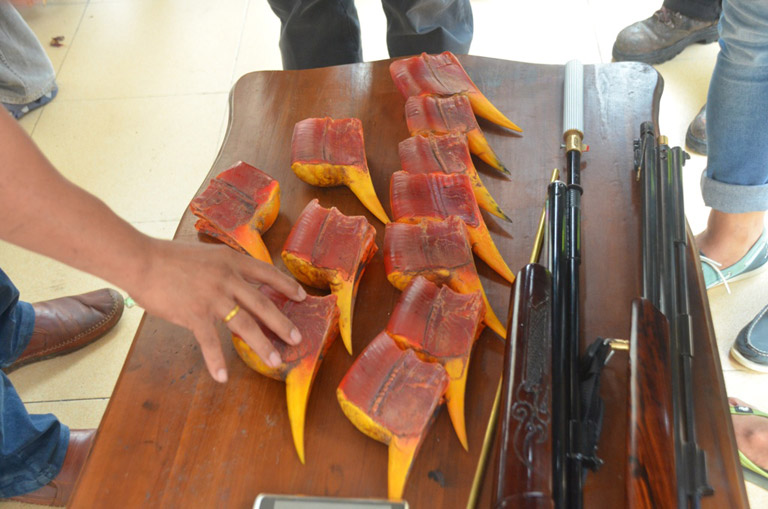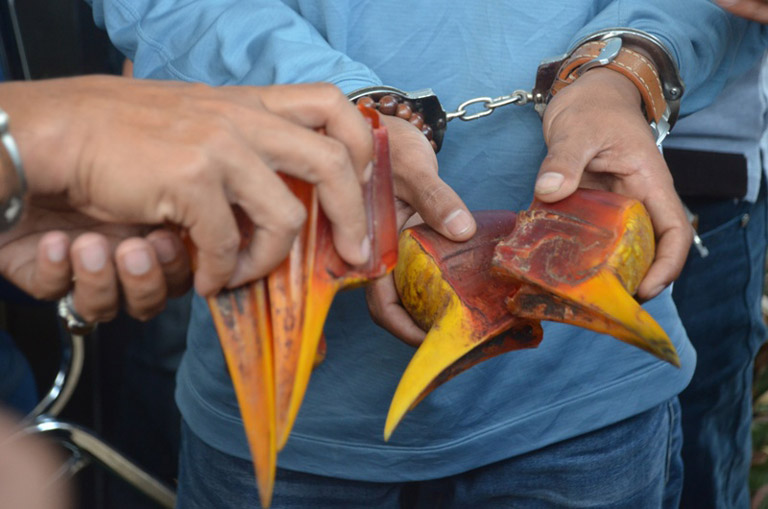- Two traders of beaks from the helmeted hornbill were arrested in Sumatra, Indonesia.
- In recent years, the price of hornbill casques have increased sharply, they now cost up to 5 times more than elephant ivory.
- The increase in demand comes from China, where it is used in traditional medicines or fashioned into valuable souvenirs.
Two traders of beaks from the helmeted hornbill were arrested in Sumatra, Indonesia, on June 12. During the arrest, authorities confiscated 12 beaks and the two suspects, known only as ZMS and ALB, confessed to selling over 120 beaks within the preceding six months. The pair is thought to have organized an operation involving 30 hunters who poached birds in the island’s threatened Leuser ecosystem, including inside Gunung Leuser National Park.
The arrest took place in the Langkat region, a 3-hour drive from Medan, the largest city on the island of Sumatra. Langkat is notorious as an entry point for poachers heading into the national park. The arrest was part of a joint investigation carried out by forest rangers from the national park, the Indonesian government, and the U.S.-based Wildlife Conservation Society, which operates a Wildlife Crimes Unit [WCU] in Indonesia.

‘The arrest shows our commitment to protecting Gunung Leuser National Park’s ecosystem which has been placed under our management. We will continue to take firm action against all poaching, destruction and encroachment of the conservation forest and work hard to preserve and protect this last stronghold for biodiversity” Andi Basrul, the park’s head, said in a statement.
Indonesia is one of the world’s biodiversity hotspots, and is home to thousands of weird and wonderful species. The helmeted hornbill (Rhinoplax vigil) fits right in. It has a wingspan of approximately five feet, a featherless and wrinkly neck, and a distinctive casque, or decorative growth, atop its upper bill — its “helmet.”
The birds live on a number of Indonesian islands, as well as in Brunei, Malaysia, Myanmar, and Thailand. But the flourishing illegal trade in their casques, as well as the destruction of their natural habitat, is diminishing their numbers and the species is now listed as near threatened by the IUCN.
In 2013, Yokyok Hadiprakarsa, a conservationist and independent hornbill expert, found that at least 500 adult helmeted hornbills were killed each month in the province of West Kalimantan alone. He also showed that between 2012 and 2014, 1,100 helmeted hornbill casques were confiscated by authorities in Indonesia en route to China.
“The poaching of helmeted hornbill has boomed among local hunters,” Dwi N. Adhiasto, program manager of the WCU in Indonesia, told mongabay.com. He believes that the reason behind it is simple. “Unlike the casques of other hornbill species, which are typically hollow and extremely light, the casques of [the] helmeted hornbill [are] a solid block of an ivory-like substance,” he said.

In recent years the price of the bird’s casque has increased sharply, with it now costing up to 5 times more than elephant ivory. This increase is driven by demand from China, where it is used in traditional medicines or fashioned into valuable souvenirs. On the black market, a casque can sell for around $1,000. Online suppliers call it “red ivory” after its color before it is carved.
Trade in any part of the helmeted hornbill is already illegal under the Convention on International Trade in Endangered Species of Wild Fauna and Flora, aka CITES. And under Indonesian law the trafficking of helmeted hornbills or any of their parts can result in a jail sentence of up to five years and a fine of $10,000.
The recent bust is not the first time traders have been arrested in Indonesia. In September 2012, authorities in West Kalimantan arrested a hornbill dealer and confiscated 270 hornbill beaks. Less than six months later, four Chinese suspects were stopped by customs at Soekarno-Hatta airport in Jakarta as they were trying to smuggle 248 hornbill beaks, worth an estimated $100,000, out of the country.
So what more can law enforcement do? The WCU advocates for strengthening existing regional law enforcement collaborations in relation to wildlife trafficking to enable improved detection of helmeted hornbill hunters at forest entry points and increased screenings at international exit points.
“Ground patrols by forest rangers should focus on roosting and feeding areas of hornbills because those areas are the most favored shooting spots for hunters. The government should also carry out open market monitoring in Jakarta since WCU investigators [have] detected carved casques being sold in the Rawabening gemstone market,” said Adhiasto. He added that helmeted hornbill habitat also needs better protection.
“The arrest proved that the threat of poaching of helmeted hornbills has become a multi island and national issue for Indonesia,” he said.